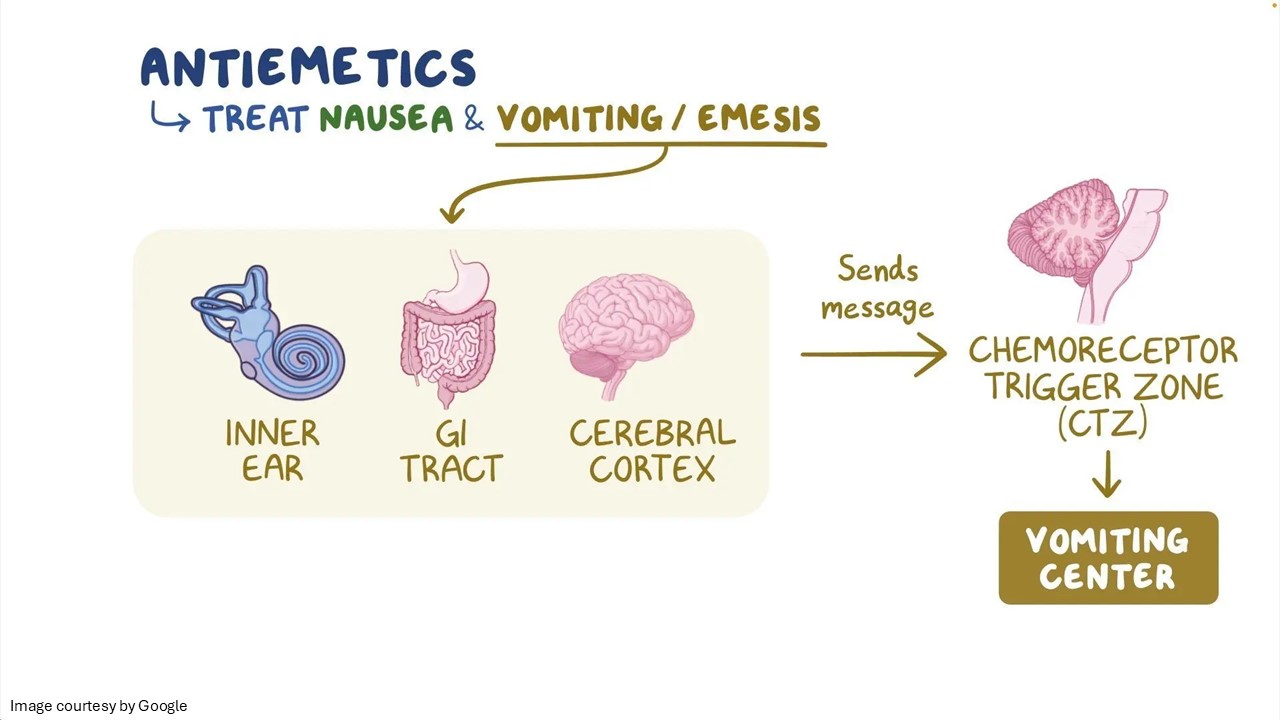The nose, which occurs due to stimulation of the emesis center located in the brain. Nausea is an unpleasant sensation that causes an involuntary urge to vomit. Both are automatic responses that shield the body from potential harm and occur due to many causes, including radiation therapy, drugs, central nervous system (CNS) disorders, gastrointestinal disorders, psychiatric disorders, and endocrinological, vestibular, and metabolic disorders. Moreover, they are adaptive behavior that works by eliminating toxic substances that have been ingested.
Severe vomiting has consequences like dehydration, electrolyte depletion, acid-base imbalance, aspiration, and pneumonia. Here comes the role of an antiemetic.
Emesis is described as a forceful emptying of the gastric contents via the mouth or sometimes through
What is antiemetic – An anti emetic is a medicine formulated to treat nausea and vomiting.
Antiemetic medicines
Antiemetic treatment aims to antagonize the neurotransmitters involved in emesis regulation. In persistent vomiting cases, antiemetic medications effectively reduce the metabolic and nutritional consequences.
An accurate form of antiemetic medicine usually depends on several factors, including the root cause, frequency, duration, severity of vomiting, age, response to previously used antiemetic drugs, etc.
Although emesis happens after radiotherapy, chemotherapy, and postoperatively, and as an adverse effect of many medications such as antidepressants, there is no ideal antiemetic formulation in the clinical industry because the existing ones only target a few stimuli that cause the triggering of reflexes.
Mode of action
As mentioned above, vomiting is considered to be a protective reflex response of the body to eliminate toxic waste in the stomach and intestines; antiemetic drugs are often required to suppress vomiting, especially to prevent consequences like dehydration.
These medications are taken orally or via intravenous route:
-
- Antihistamines: This class of antiemetic medications helps prevent nausea and vomiting associated with motion sickness.
- Antimetics in pregnancy: These are the medications that are often prescribed to pregnant women to relieve their symptoms of motion sickness.
- Antiemetic for stomach flu: These drugs help alleviate symptoms of gastroenteritis.
- Antiemetics after surgery: These drugs are used to prevent anesthesia’s aftereffects.
- Antiemetic medications for cancer and chemotherapy: These medications prevent adverse effects associated with chemotherapy and enhance the quality of life.
Antiemetic medications must be used under the supervision of a doctor to achieve optimal results. These medications should only be prescribed when an individual needs them after examining the underlying cause, the severity of the condition, and the possible adverse reactions.
Different Antiemetics works in different ways:
-
- The vomiting center starts and controls the episode of emesis, including a series of contractions of the smooth muscles around the digestive tract. Triggers like strong smells, thoughts, and motion triggers activate this center.
- Antiemetic drugs adhere to the receptors in the brain’s vomiting center and restrict their pathways where signals are sent to cause nausea and vomiting, thus reducing the nausea sensation.
- The emetic reflex is mediated through chemical messengers called neurotransmitters, including dopamine, acetylcholine, histamine, serotonin, and neurokinin.
- Antiemetic medications inhibit the activity of these neurotransmitters, which stops the signals of nausea from being sent and helps to control vomiting.
- They stop the stimulation of the gastrointestinal tract, abdominal muscles, and diaphragm.
- Furthermore, these medications are believed to produce a calming effect on the brain, which may lead to drowsiness.

The types of antiemetic drugs
Antiemetics are classified into seven subgroups of antiemetic medications, most of which encompass multiple medications.
-
- Serotonin antagonists: These medications are specifically formulated to treat nausea and vomiting. These are commonly prescribed antiemetic drugs. These include ondansetron, granisetron, and palonosetron.
These medications have received the approval of the Food and Drug Administration for the prevention of chemotherapy-induced nausea and vomiting and postoperative nausea and vomiting.
-
- Glucocorticoids
Glucocorticoids are primarily recognized for their anti-inflammatory and anti-allergic properties. But some are also prescribed as antiemetic agents.
The commonly prescribed glucocorticoid is Dexamethasone, which is used to prevent chemotherapy-induced nausea and vomiting and postoperative nausea and vomiting. Doctors may combine a glucocorticoid and other antiemetics to prevent nausea and vomiting for better results. Unlike some other antiemetic drugs, glucocorticoids can’t be used for the treatment of nausea and vomiting once they have started.
-
- Antihistamine
These help to manage allergic symptoms. Some receive FDA approval to treat and prevent nausea, vomiting, and emesis associated with motion sickness or vertigo. Examples of antiemetic antihistamines include diphenhydramine, doxylamine succinate, dimenhydrinate chewable tablets, promethazine, and meclizine.
-
- Anticholinergics
Anticholinergics are known to block the activity of certain neurotransmitters. They are useful in treating various conditions, including chronic obstructive pulmonary disease (COPD) and urinary incontinence, but are equally effective in reducing nausea and vomiting.
One of the main antiemetic anticholinergics is Scopolamine, and doctors prescribe it to prevent postoperative nausea and vomiting. It may also prevent or treat nausea and vomiting associated with motion sickness.
-
- Dopamine antagonists
Dopamine antagonists are medicines that stop the activity of specific types of brain cells. These drugs are extremely effective in treating mental health conditions and symptoms, particularly schizophrenia and psychosis. However, some types of medicine can be used to treat nausea and vomiting. Dopamine antagonists used as antiemetic agents are chlorpromazine, haloperidol, amisulpride, metoclopramide, droperidol, prochlorperazine, and olanzapine.
These medications are effective alternatives when other medications do not work for chemotherapy-induced nausea and vomiting. This medication can also be given to stop postoperative nausea and vomiting.
-
- Neurokinin-1 receptor antagonists
These work by blocking the action of a natural substance called neurokinin in your brain, which is responsible for causing nausea and vomiting. These treat chemotherapy-induced and postoperative nausea and vomiting. These include Fosaprepitant, aprepitant, rolapitant, and netupitant and palonosetron combination.
-
- Cannabinoids
These can stick to cannabinoid receptors in the brain, immune cells, and gastrointestinal tract. Two cannabinoids for use as antiemetics are Nabilone and Dronabinol.
Side effects of Antiemetics
Common antiemetic side effects include constipation, drowsiness, headache, dry mouth, fatigue, and loss of appetite. Other rare side effects include unusual weakness, slow heartbeat, blurred vision, urinary retention, hypertension/hypotension, and hallucinations (involving seeing, hearing, smelling, feeling, etc.)
Conclusion
While numerous antiemetics are available that are considered effective, the choice of a particular medication for an individual patient can vary depending on several factors. The factors that need to be considered include the patient’s age, the indication for treatment, health comorbidities, pregnancy status, and the risk of side effects.


